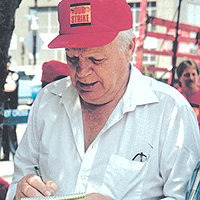The Labor Department’s December unemployment report provided the background as Congressional Democrats and the White House began staking out the ground for the legislative battles. Congress will reconvene Jan. 23 and President Bush will make his State of the Union address on Jan. 29.
The report, which says the number of unemployed workers stands at more than 8.3 million, was issued the same day that Senator Tom Daschle outlined the Democratic program for stimulating the economy.
In his speech Daschle called for improvement in the unemployment compensation system and for health care benefits for laid-off workers. He rejected Bush’s claim that the Sept. 11 terrorist attacks had sent the economy into a tailspin, saying the biggest reason was Bush’s tax cut that chewed up more than half of the surplus.
The unemployment report drew an angry response from AFL-CIO President John Sweeney, who called the statistics “a bleak reminder” of the urgency of federal action to help the unemployed and a “sharp rebuke” to President Bush and Congressional Republicans. He called their failure to act an “insult to the men and women who work for a living.”
Roger Hickey, co-chair of the Campaign for America’s Future, said the progressive movement had scored a victory when the Senate prevented Bush from “shoveling” even more money to the rich.
“We’ve got to keep that momentum rolling,” he said. “Don’t forget, this year is an election year and many of these battles will be fought out then.”
The unemployment report, showing that “only” 124,000 jobs were lost in December, has been seized by Wall Street pundits as proof that the recession has bottomed and that recovery is but weeks away. Richard Berner, a Goldman Sachs economist, told The Wall Street Journal the recession “appears to be ending” and predicted the economy will grow by 3.6 percent this year.
Victor Zarnowitz, a senior fellow at the Conference Board, is even more optimistic, saying it is “conceivable” that the recession ended in December 2001. Neither Jared Bernstein nor Art Perlo agree with these rosy predictions.
Bernstein, a senior economist at the Economic Policy Institute told the World layoffs will continue through 2002 with the unemployment rate climbing to 6.5 percent before year’s end. “The unemployment rate, not the stock market, is the real indicator of whether or not the economy has begun to recover,” he said.
Perlo, chair of the Communist Party Economic Commission, said Wall Street economists have only one measure – corporate profits – for predicting a recovery.
“If they go up, the economy is recovering. If they don’t, the recession is still on,” Perlo said. “But either way working people can expect continuing layoffs, lower real wages, and fewer benefits in coming months. State and city budgets are being squeezed, which will mean higher taxes if you’re working, a tattered safety net if you’re unemployed and declining public services for very one.”
Scott Marshall, Communist Party labor secretary, called for a “major overhaul” of the unemployment insurance program.
“Fewer than 40 percent of the unemployed draw benefits,” he said. “Hundreds of thousands more have exhausted them and nearly a million workers have lost their health insurance since the recession began. These numbers are bound to grow, which means additional hardship for millions unless Congress adopts a stimulus package and does it soon.”
Marshall added that unemployment benefits should be paid “from the time a worker loses a job until he or she returns to work.” December’s job losses were concentrated in the manufacturing sector.
Over the past year, manufacturing employment is down 7.2 percent, a much larger annual percentage drop than occurred over the last recession. Over the past three months, employment in retail is down by over 200,000. The only bright spots in the December picture were an increase of 72,000 service sector jobs and a 62,000 increase in the number of government workers.
Although layoffs have hit all demographic groups, unemployment rates have increased more among those most vulnerable to swings in the economy.
Over the past year, unemployment is up 1.6 percentage points among white workers, but it is up 2.7 points among African Americans (3.1 points for adult Black women, 6.8 for Black teens) and 2.1 points for Latinos. Unemployment also rose more among blue-collar workers (2.8 points) than among managers and professionals (1.2 points). Average hourly wages increased by seven cents in December.

MOST POPULAR TODAY


Zionist organizations leading campaign to stop ceasefire resolutions in D.C. area

Communist Karol Cariola elected president of Chile’s legislature

Afghanistan’s socialist years: The promising future killed off by U.S. imperialism

High Court essentially bans demonstrations, freedom of assembly in Deep South



Comments